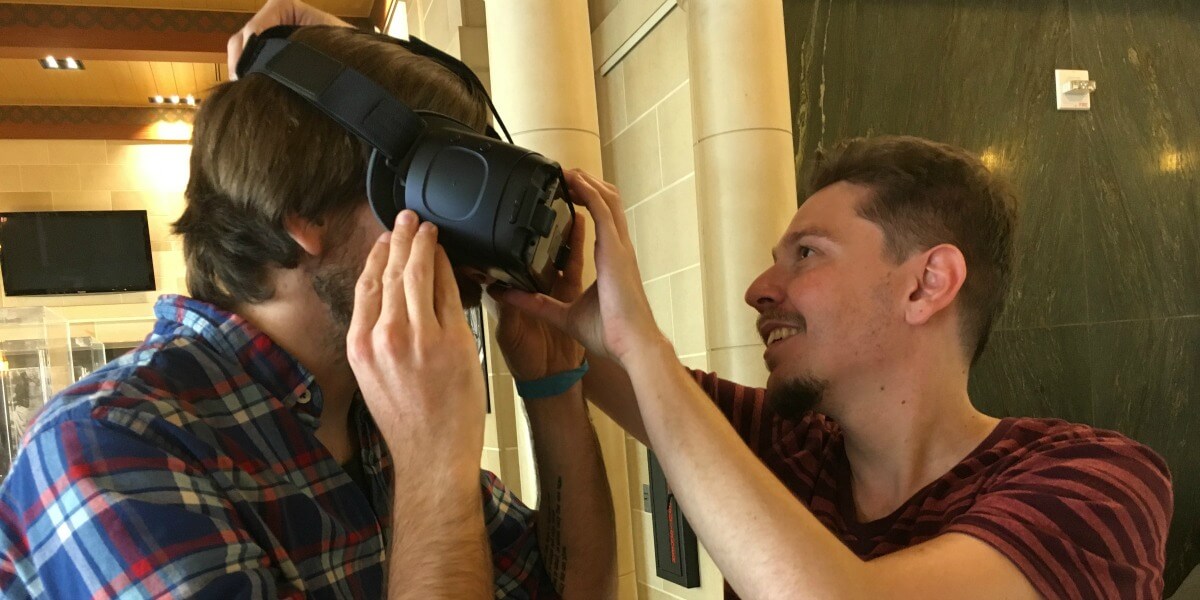
Filmmaker David Beier (right) assists a viewer /Tiana Lowe
Like a character from Seurat’s La Grande Jette sprung to life, a 5-foot-8 man made entirely out of dots waves and walks right through me. The experience is just surreal enough to avoid falling into the uncanny valley of an experience too close, but not close enough, to reality.
This virtual reality experience, depicting a number of scenes with point cloud and polygon-crafted figures and scenes, is referred to as as “Kinect Videogrammetry” by its creator, Brian Handy, a masters student in game and interactive media design at USC School of Cinematic Arts. Handy’s creation is in fact a volumetric capture setup achieving millimeter accuracy for under $1000.
Plenty of the VR displays at the second ever VRSC Student Festival this April employed newly innovated, budget VR hardware, such as the Google Daydream, which sells for under $100. With VR emerged from its infancy, students and alumni alike presented radically new approaches to the 360 degree immersion of virtual reality. VRSC, USC’s largest immersive technology student organization, was founded back in in 2015 by Jake Green, then a USC Viterbi mechanical engineering student.
In 2016, Handy partnered with USC Viterbi’s Jyotsna Kadimi, M.S. electrical engineering ‘16, and then president of the VRSC, as part of the MxR Lab’s research effort developing the “Language of VR” to determine “best practices” for creating rich “mixed environments.” They were known on campus as “The Left of Boom” team, a nod to a term used by the Pentagon for proactive missions.
Left of Boom was selected as one of the three finalists in the Future of Digital Health 10th Annual USC Global Body Computing Conference’s 2nd Annual VR Hackathon, with their submission “The Bystander Project.”
In Bystander, a participant puts on the HTC Vive headset and is transported to a college house party where they are encouraged to look for signs of potential sexual harassment or abuse, and act upon them. This leads the participant to discover that they have the power to manipulate time, to pause, rewind and change the outcome of the scenario through the use of their presence and voice, ultimately recognizing the importance of being an active bystander.
Left of Boom was an amalgam of storytellers and engineers including: Kadimi, Allison Comrie, John Francis, Brian Handy, Duc Ho, Chris Horrigan, Mari Kyle, Atley Loughridge and Vathsal Shashidhar. Their successful experiments in VR and AR gave producers like David Beier the courage to push boundaries in experiential VR and to delve into surrealism.
Beier, M.F.A. film and television ’14, framed “Going Home” from the perspective of a dying man oscillating from present visions at a hospital to flashbacks of young adulthood and fatherhood.
“I had an issue with a lot of 360 VR movies where I would feel like I was watching a play,” said Beier who produced “Going Home” though USC’s Jaunt Cinematic VR Lab.
“They would stick you somewhere in every scene, so you can look everywhere, but there’s no perspective or true point of view. We asked ourselves, how could we do something where we really created a subjective experience and you’re really an integral part of the story?”
In this case, Beier and his team wanted to know what if would feel like to be dying.
“A lot of VR movies currently feel very passive, so we wanted to create a feeling of immersion. In ‘Going Home,’ we’re seeing everything from one guy’s experience,” he said.
To create this effect, Beier used the protagonist’s wife as a focal point, moving around the different rooms, to keep the viewer focused and the narrative consistent. Rather than have a setting feel like a stage, the effect becomes intimate and subjective.
“VR is kind of in its pimply adolescent stage, where it’s still kind of awkward. Even though there’s a lot of hype and a lot of money, a lot of the content doesn’t really live up to it,” said Cecilia Sweet-Coll, B.F.A. animation ’16.
“The real question to ask and to try and live up to is how to make VR something more than a film with a lot of extra frills around it.”
Sweet-Coll’s film “West Adams” blends a real shot of the neighborhood’s intersection of 29th and Halldale Avenue with dreamlike animations – not to render the real life setting unbelievable, but to highlight a subtle, but already existent tranquility of the street corner.
Yet for all of the beauty of the dozens of projects displayed at VRSC, the engineering behind it remains a vital force.
“You have a VR experience running at 90 frames per second for most people, or you end up with a disconnect between your eye and your inner ear that causes most people to get motion sickness, because the only thing your body knows that causes that sort of disconnect is poison,” Handy said. “That’s why if you get carsick or if you’re in a bad VR experience that starts to lag, you start to feel really sick, because you’re body’s trying to get you to throw up.”
Hardy’s Kinect Videogrammetry project technically finesses lifelike movement and frames, presenting the point cloud version of himself mentioned above as well as rooms and people comprised of polygons. Even without the cinematic and narrative elements of Sweet-Coll and Beier’s pieces, Hardy’s project plays out less like a stage to be observed objectively and more like a living, breathing space with a guided perspective.
“VR runs the risk of being outpaced by augmented reality because we can forgive lower frame rates when it’s in relation to the real world,” Handy noted. “Because AR is much less technically demanding, more people are eager to invest in AR rather than VR.”
Still, with the level of interest exemplified by the Jaunt Lab incubator as well as VRSC as a whole, Silicon Beach seems unlikely to give up just as VR makes the leap from machine to experience.
“You can make these sorts of surreal worlds in Photoshop or After Effects, but the Jaunt Lab is more interested in pushing the boundaries of crafting experiences instead of spectacles,” Beier said.
“As we use more cinematic techniques combined with low cost, high tech advancements, we can view VR in a way that’s neither additive nor subtractive, sculpting an actual experience instead of burying it.”
Published on May 4th, 2017
Last updated on May 16th, 2024










